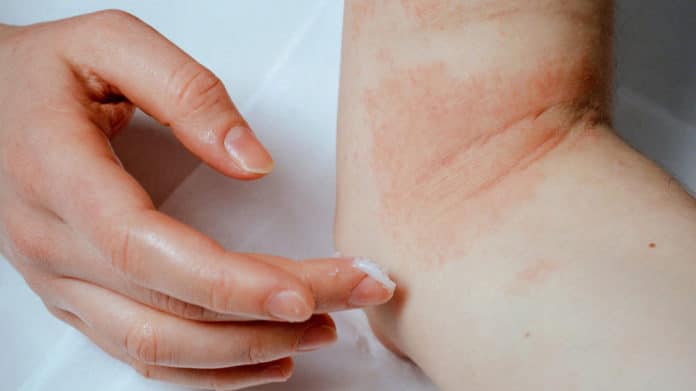Atopic dermatitis (AD) is eczema that affects 13% of children and 10% of adults. Such patients have super sensitive skin and a decreased threshold for irritation.
There is currently no Dermatitis Treatment. An old study published in the journal Trials suggests that ‘The foundation of all treatment is the regular use of leave-on emollients to preserve and restore moisture to the skin.’
A major hallmark of AD is an elevation of the immune cytokines IL-4 and IL-13. These cytokines lead to skin barrier disruption and lipid abnormalities in AD, yet the underlying mechanisms are unclear.
A new study led by UT Southwestern dermatologists suggests that a common inflammatory skin condition may stem from poorly regulated sex hormones. Scientists have shown that a gene essential for making sex hormones plays a role in the skin making its moisturizers. Altering this gene’s activity could potentially offer better Atopic Dermatitis Treatment.
In a past study, scientists found that Atopic dermatitis is linked with overactivity in genes responsible for producing two inflammatory immune molecules, interleukins 4 and 13 (IL-4 and IL-13).
A drug called dupilumab, a monoclonal antibody that alleviates the amount of the inflammatory molecules, was found to be effective in many patients with moderate to severe AD. However, the molecular mechanisms behind how IL-4 and IL-13 contribute to this form of eczema were unknown.
Scientists focused on sebocytes, the cells that make up sebaceous glands, to explore the answer to this question. These glands produce an oily, waxy barrier that coats the skin, helping it retain moisture.
Scientists dosed human sebocytes growing in Petri dishes with IL-4 and IL-13. By using RNA sequencing, they were able to read the gene activity for the entire genome. Later, they compared it with gene activity in sebocytes that weren’t treated with these immune molecules.
They found that a gene called HSD3B1, which makes an enzyme called 3b-hydroxysteroid dehydrogenase 1, became up to 60 times more active when exposed to the two interleukins.
Corresponding author Tamia Harris-Tryon, M.D., Ph.D., Assistant Professor of Dermatology and Immunology at UTSW, said, “The finding was a surprise because this enzyme is well known for playing a key role in the production of sex hormones such as testosterone and progesterone, but it had never been linked to atopic dermatitis and skin lipid production.”
“Databases of human gene activity showed that HSD3B1 tends to be overactive in patients with eczema; a single study of patients on dupilumab showed that this drug appears to lower HSD3B1’s activity. Both pieces of evidence suggest that IL-4 and IL-13 drive up the activity of this gene.”
Scientists later manipulated HSD3B1’s activity in sebocytes to determine how this gene affects sebum output. They found that when they made this gene less active, sex hormones decreased, and skin sebum production increased. The reverse was also true, with more gene activity leading to higher sex hormones and less sebum.
The same results were obtained in a mouse model of AD.
Dr. Harris-Tryon said, “These findings suggest that HSD3B1 could be a new target for fighting AD and potentially other forms of eczema. Changing the output of this gene could eventually offer a way to treat AD that’s completely different from any treatment that currently exists.”
Journal Reference:
- Chenlu Zhang et al. Interleukins 4 and 13 drive lipid abnormalities in skin cells by regulating sex steroid hormone synthesis. DOI: 10.1073/pnas.2100749118
